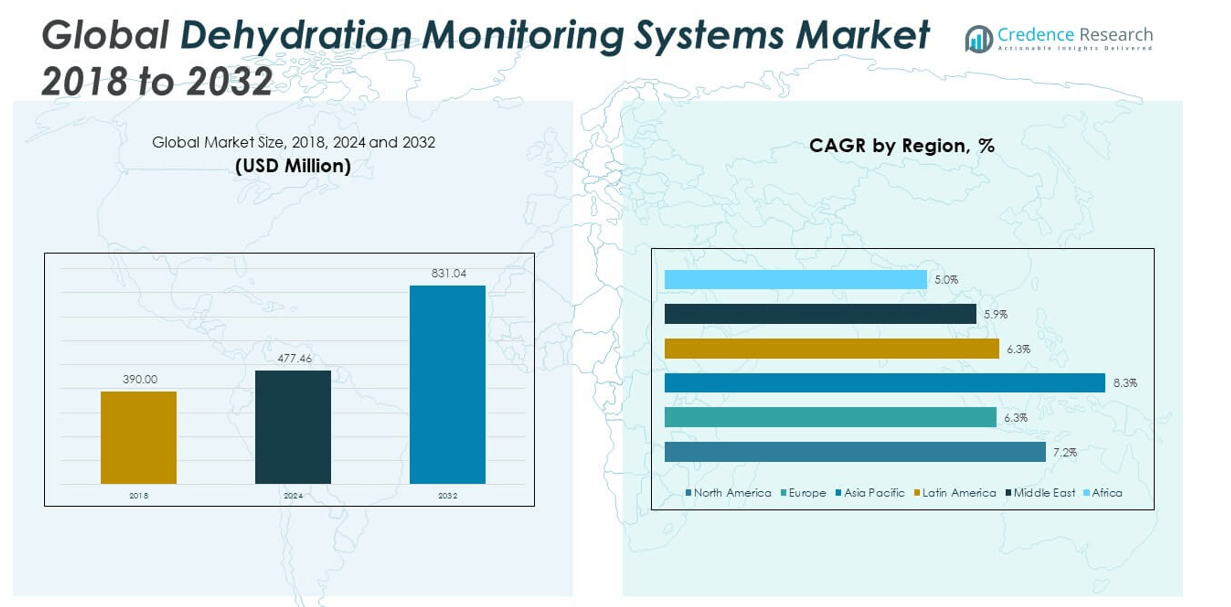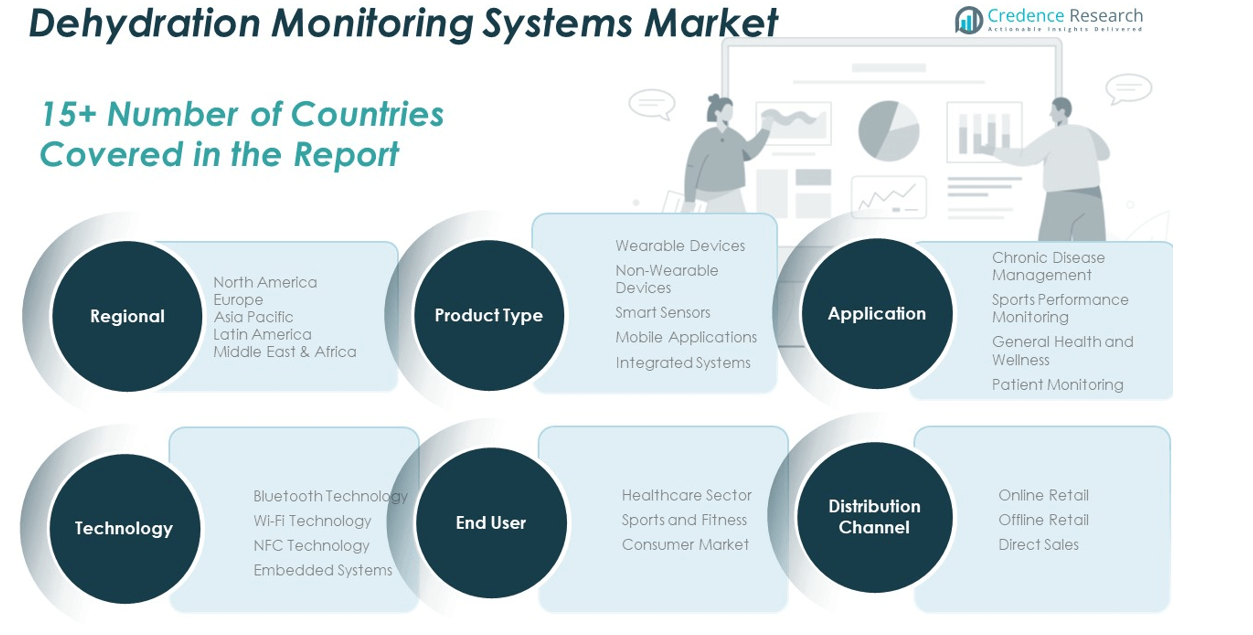CHAPTER NO. 1 : GENESIS OF THE MARKET
1.1 Market Prelude – Introduction & Scope
1.2 The Big Picture – Objectives & Vision
1.3 Strategic Edge – Unique Value Proposition
1.4 Stakeholder Compass – Key Beneficiaries
CHAPTER NO. 2 : EXECUTIVE LENS
2.1 Pulse of the Industry – Market Snapshot
2.2 Growth Arc – Revenue Projections (USD Million)
2.3. Premium Insights – Based on Primary Interviews
CHAPTER NO. 3 : DEHYDRATION MONITORING SYSTEMS MARKET FORCES & INDUSTRY PULSE
3.1 Foundations of Change – Market Overview
3.2 Catalysts of Expansion – Key Market Drivers
3.2.1 Momentum Boosters – Growth Triggers
3.2.2 Innovation Fuel – Disruptive Technologies
3.3 Headwinds & Crosswinds – Market Restraints
3.3.1 Regulatory Tides – Compliance Challenges
3.3.2 Economic Frictions – Inflationary Pressures
3.4 Untapped Horizons – Growth Potential & Opportunities
3.5 Strategic Navigation – Industry Frameworks
3.5.1 Market Equilibrium – Porter’s Five Forces
3.5.2 Ecosystem Dynamics – Value Chain Analysis
3.5.3 Macro Forces – PESTEL Breakdown
3.6 Price Trend Analysis
3.6.1 Regional Price Trend
3.6.2 Price Trend by product
CHAPTER NO. 4 : KEY INVESTMENT EPICENTER
4.1 Regional Goldmines – High-Growth Geographies
4.2 Product Frontiers – Lucrative Product Categories
4.3 Application Sweet Spots – Emerging Demand Segments
CHAPTER NO. 5: REVENUE TRAJECTORY & WEALTH MAPPING
5.1 Momentum Metrics – Forecast & Growth Curves
5.2 Regional Revenue Footprint – Market Share Insights
5.3 Segmental Wealth Flow – Device Type & Application Revenue
CHAPTER NO. 6 : TRADE & COMMERCE ANALYSIS
6.1. Import Analysis by Region
6.1.1. Global Dehydration Monitoring Systems Market Import Revenue By Region
6.2. Export Analysis by Region
6.2.1. Global Dehydration Monitoring Systems Market Export Revenue By Region
CHAPTER NO. 7 : COMPETITION ANALYSIS
7.1. Company Market Share Analysis
7.1.1. Global Dehydration Monitoring Systems Market: Company Market Share
7.2. Global Dehydration Monitoring Systems Market Company Revenue Market Share
7.3. Strategic Developments
7.3.1. Acquisitions & Mergers
7.3.2. New Product Launch
7.3.3. Regional Expansion
7.4. Competitive Dashboard
7.5. Company Assessment Metrics, 2024
CHAPTER NO. 8 : DEHYDRATION MONITORING SYSTEMS MARKET – BY DEVICE TYPE SEGMENT ANALYSIS
8.1. Dehydration Monitoring Systems Market Overview by Device Type Segment
8.1.1. Dehydration Monitoring Systems Market Revenue Share By Device Type
8.2. Wearable Devices
8.3. Non-Wearable Devices
8.4. Smart Sensors
8.5. Mobile Applications
8.6. Integrated Systems
CHAPTER NO. 9 : DEHYDRATION MONITORING SYSTEMS MARKET – BY APPLICATION SEGMENT ANALYSIS
9.1. Dehydration Monitoring Systems Market Overview by Application Segment
9.1.1. Dehydration Monitoring Systems Market Revenue Share By Application
9.2. Chronic Disease Management
9.3. Sports Performance Monitoring
9.4. General Health and Wellness
9.5. Patient Monitoring
CHAPTER NO. 10 : DEHYDRATION MONITORING SYSTEMS MARKET – BY TECHNOLOGY SEGMENT ANALYSIS
10.1. Dehydration Monitoring Systems Market Overview by Technology Segment
10.1.1. Dehydration Monitoring Systems Market Revenue Share By Technology
10.2. Bluetooth Technology
10.3. Wi-Fi Technology
10.4. NFC Technology
10.5. Embedded Systems
CHAPTER NO. 11 : DEHYDRATION MONITORING SYSTEMS MARKET – BY END USER SEGMENT ANALYSIS
11.1. Dehydration Monitoring Systems Market Overview by End User Segment
11.1.1. Dehydration Monitoring Systems Market Revenue Share By End User
11.2. Healthcare Sector
11.3. Sports and Fitness
11.4. Consumer Market
CHAPTER NO. 12 : DEHYDRATION MONITORING SYSTEMS MARKET – BY DISTRIBUTION CHANNEL SEGMENT ANALYSIS
12.1. Dehydration Monitoring Systems Market Overview by Distribution Channel Segment
12.1.1. Dehydration Monitoring Systems Market Revenue Share By Distribution Channel
12.2. Online Retail
12.3. Offline Retail
12.4 Direct Sales
CHAPTER NO. 13 : DEHYDRATION MONITORING SYSTEMS MARKET – REGIONAL ANALYSIS
13.1. Dehydration Monitoring Systems Market Overview by Region Segment
13.1.1. Global Dehydration Monitoring Systems Market Revenue Share By Region
13.1.2. Regions
13.1.3. Global Dehydration Monitoring Systems Market Revenue By Region
13.1.4. Device Type
13.1.5. Global Dehydration Monitoring Systems Market Revenue By Device Type
13.1.6. Application
13.1.7. Global Dehydration Monitoring Systems Market Revenue By Application
13.1.8. Technology
13.1.9. Global Dehydration Monitoring Systems Market Revenue By Technology
13.1.10. End User
13.1.12. Global Dehydration Monitoring Systems Market Revenue By End User
13.1.13. Distribution Channel
13.1.14. Global Dehydration Monitoring Systems Market Revenue By Distribution Channel
CHAPTER NO. 14 : NORTH AMERICA DEHYDRATION MONITORING SYSTEMS MARKET – COUNTRY ANALYSIS
14.1. North America Dehydration Monitoring Systems Market Overview by Country Segment
14.1.1. North America Dehydration Monitoring Systems Market Revenue Share By Region
14.2. North America
14.2.1. North America Dehydration Monitoring Systems Market Revenue By Country
14.2.2. Device Type
14.2.3. North America Dehydration Monitoring Systems Market Revenue By Device Type
14.2.4. Application
14.2.5. North America Dehydration Monitoring Systems Market Revenue By Application
14.2.6. Technology
14.2.7. North America Dehydration Monitoring Systems Market Revenue By Technology
14.2.8. End User
14.2.9. North America Dehydration Monitoring Systems Market Revenue By End User
14.2.10. Distribution Channel
14.2.11. North America Dehydration Monitoring Systems Market Revenue By Distribution Channel
14.3. U.S.
14.4. Canada
14.5. Mexico
CHAPTER NO. 15 : EUROPE DEHYDRATION MONITORING SYSTEMS MARKET – COUNTRY ANALYSIS
15.1. Europe Dehydration Monitoring Systems Market Overview by Country Segment
15.1.1. Europe Dehydration Monitoring Systems Market Revenue Share By Region
15.2. Europe
15.2.1. Europe Dehydration Monitoring Systems Market Revenue By Country
15.2.2. Device Type
15.2.3. Europe Dehydration Monitoring Systems Market Revenue By Device Type
15.2.4. Application
15.2.5. Europe Dehydration Monitoring Systems Market Revenue By Application
15.2.6. Technology
15.2.7. Europe Dehydration Monitoring Systems Market Revenue By Technology
15.2.8. End User
15.2.9. Europe Dehydration Monitoring Systems Market Revenue By End User
15.2.10. Distribution Channel
15.2.11. Europe Dehydration Monitoring Systems Market Revenue By Distribution Channel
15.3. UK
15.4. France
15.5. Germany
15.6. Italy
15.7. Spain
15.8. Russia
15.9. Rest of Europe
CHAPTER NO. 16 : ASIA PACIFIC DEHYDRATION MONITORING SYSTEMS MARKET – COUNTRY ANALYSIS
16.1. Asia Pacific Dehydration Monitoring Systems Market Overview by Country Segment
16.1.1. Asia Pacific Dehydration Monitoring Systems Market Revenue Share By Region
16.2. Asia Pacific
16.2.1. Asia Pacific Dehydration Monitoring Systems Market Revenue By Country
16.2.2. Device Type
16.2.3. Asia Pacific Dehydration Monitoring Systems Market Revenue By Device Type
16.2.4. Application
16.2.5. Asia Pacific Dehydration Monitoring Systems Market Revenue By Application
16.2.6. Technology
16.2.7. Asia Pacific Dehydration Monitoring Systems Market Revenue By Technology
16.2.8. End User
16.2.9. Asia Pacific Dehydration Monitoring Systems Market Revenue By End User
16.2.10. Distribution Channel
16.2.11. Asia Pacific Dehydration Monitoring Systems Market Revenue By Distribution Channel
16.3. China
16.4. Japan
16.5. South Korea
16.6. India
16.7. Australia
16.8. Southeast Asia
16.9. Rest of Asia Pacific
CHAPTER NO. 17 : LATIN AMERICA DEHYDRATION MONITORING SYSTEMS MARKET – COUNTRY ANALYSIS
17.1. Latin America Dehydration Monitoring Systems Market Overview by Country Segment
17.1.1. Latin America Dehydration Monitoring Systems Market Revenue Share By Region
17.2. Latin America
17.2.1. Latin America Dehydration Monitoring Systems Market Revenue By Country
17.2.2. Device Type
17.2.3. Latin America Dehydration Monitoring Systems Market Revenue By Device Type
17.2.4. Application
17.2.5. Latin America Dehydration Monitoring Systems Market Revenue By Application
17.2.6. Technology
17.2.7. Latin America Dehydration Monitoring Systems Market Revenue By Technology
17.2.8. End User
17.2.9. Latin America Dehydration Monitoring Systems Market Revenue By End User
17.2.10. Distribution Channel
17.2.11. Latin America Dehydration Monitoring Systems Market Revenue By Distribution Channel
17.3. Brazil
17.4. Argentina
17.5. Rest of Latin America
CHAPTER NO. 18 : MIDDLE EAST DEHYDRATION MONITORING SYSTEMS MARKET – COUNTRY ANALYSIS
18.1. Middle East Dehydration Monitoring Systems Market Overview by Country Segment
18.1.1. Middle East Dehydration Monitoring Systems Market Revenue Share By Region
18.2. Middle East
18.2.1. Middle East Dehydration Monitoring Systems Market Revenue By Country
18.2.2. Device Type
18.2.3. Middle East Dehydration Monitoring Systems Market Revenue By Device Type
18.2.4. Application
18.2.5. Middle East Dehydration Monitoring Systems Market Revenue By Application
18.2.6. Technology
18.2.7. Middle East Dehydration Monitoring Systems Market Revenue By Technology
18.2.8. End User
18.2.9. Middle East Dehydration Monitoring Systems Market Revenue By End User
18.2.10. Distribution Channel
18.2.11. Middle East Dehydration Monitoring Systems Market Revenue By Distribution Channel
18.3. GCC Countries
18.4. Israel
18.5. Turkey
18.6. Rest of Middle East
CHAPTER NO. 19 : AFRICA DEHYDRATION MONITORING SYSTEMS MARKET – COUNTRY ANALYSIS
19.1. Africa Dehydration Monitoring Systems Market Overview by Country Segment
19.1.1. Africa Dehydration Monitoring Systems Market Revenue Share By Region
19.2. Africa
19.2.1. Africa Dehydration Monitoring Systems Market Revenue By Country
19.2.2. Device Type
19.2.3. Africa Dehydration Monitoring Systems Market Revenue By Device Type
19.2.4. Application
19.2.5. Africa Dehydration Monitoring Systems Market Revenue By Application
19.2.6. Technology
19.2.7. Africa Dehydration Monitoring Systems Market Revenue By Technology
19.2.8. End User
19.2.9. Africa Dehydration Monitoring Systems Market Revenue By End User
19.2.10. Distribution Channel
19.2.11. Africa Dehydration Monitoring Systems Market Revenue By Distribution Channel
19.3. South Africa
19.4. Egypt
19.5. Rest of Africa
CHAPTER NO. 20 : COMPANY PROFILES
20.1. Koninklijke Philips N.V.
20.1.1. Company Overview
20.1.2. Product Portfolio
20.1.3. Financial Overview
20.1.4. Recent Developments
20.1.5. Growth Strategy
20.1.6. SWOT Analysis
20.2. Baxter International Inc.
20.3. Hill-Rom Holdings, Inc.
20.4. Masimo Corporation
20.5. Otsuka Holdings Co., Ltd.
20.6. Abbott Laboratories
20.7. GE HealthCare
20.8. Medtronic plc
20.9. Siemens Healthineers
20.10 ZOLL Medical Corporation





